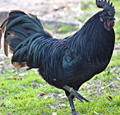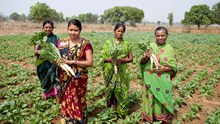
The Aravali Chicken is a registered indigenous poultry breed recognized by the ICAR-National Bureau of Animal Genetic Resources (ICAR-NBAGR), Karnal. This dual-purpose breed, valued for both meat and egg production, is known for its adaptability and resilience. The Aravali Chicken plays a crucial role in rural poultry farming. This breed thrives in rural settings, providing both meat and eggs while demonstrating exceptional resilience to varying agro-climatic conditions. Its ability to survive and flourish in different environments makes it a valuable genetic resource, ensuring sustainable poultry farming for small-scale farmers.
Indigenous Recognition and Accession Details
Recognizing the breed's distinct characteristics and contributions to Indian poultry diversity, the ICAR-NBAGR officially registered Aravali Chicken as an indigenous breed under the Accession Number: INDIA_CHICKEN_0400_ARAVALI_12020. This registration signifies the breed’s historical and genetic importance, ensuring systematic documentation and conservation efforts of its unique traits.
Distribution and Native Tract
Aravali Chicken's native tract lies within Gujarat State, where it has been traditionally bred and reared for both commercial and subsistence farming. The breed is predominantly raised in Banaskantha, Sabarkantha, Aravalli, and Mahisagar districts, where poultry farming forms an integral part of rural livelihoods.
Given Gujarat’s diverse landscape and climate, Aravali Chicken has evolved to endure fluctuating temperatures and environmental conditions, making it highly suitable for extensive and free-range farming.
Physical Characteristics and Coat Variations
Aravali Chicken exhibits a predominantly black coat, which offers natural camouflage in rural surroundings, minimizing predation risk. Some variations within the breed exhibit rusty gray plumage, adding to the genetic diversity and aesthetic appeal of the poultry.
Unlike commercial broiler chickens, which are bred specifically for uniformity in appearance and rapid growth, Aravali Chicken retains its indigenous robustness and distinctive physical traits that contribute to its adaptability.
Egg Production and Utility
As a dual-purpose breed, Aravali Chicken is reared for both its meat and egg production capabilities. The average annual egg yield stands at 72 eggs per bird, making it a moderate producer compared to high-yield commercial layers. While not ideal for intensive egg farming, Aravali Chicken serves as a dependable poultry breed for small-scale farmers who require steady egg production alongside meat yield.
Rural farmers benefit from this breed’s ability to produce eggs without requiring expensive artificial feed supplements, as it efficiently thrives on locally available feed resources.
Adaptability and Acclimatization
One of the standout features of the Aravali Chicken is its remarkable adaptability. This breed thrives in diverse agro-climatic regions of India, showing resilience to varying environmental conditions. Its ability to withstand local climatic challenges makes it ideal for free-range rural poultry farming, where feed availability and environmental exposure can fluctuate.
A standout trait of Aravali Chicken is its resilience and adaptability. The breed demonstrates a high tolerance for varying agro-climatic conditions, making it a preferred choice for farmers across India. Its hardy nature allows it to withstand environmental fluctuations, including temperature extremes, humidity variations, and changing rainfall patterns.
This adaptability ensures that farmers experience lower mortality rates, as the breed does not require extensive veterinary intervention or climate-controlled facilities. Its robust nature makes it well-suited to low-input poultry farming, where resources such as commercial feed and supplements may be limited.
Role in Sustainable Poultry Farming
The recognition of Aravali Chicken as an indigenous breed plays a crucial role in preserving genetic diversity and ensuring food security for rural communities. Since the breed thrives in free-range conditions and efficiently utilizes local feed sources, it helps promote sustainable poultry practices that reduce dependency on commercialized farming techniques.
Moreover, indigenous poultry breeds such as Aravali Chicken contribute to ecological balance by maintaining traditional farming methods that integrate livestock into natural environments without causing ecological strain.
Economic and Social Impact
By investing in indigenous breeds like Aravali Chicken, farmers can improve their livelihoods and economic stability. The breed provides both eggs and meat, catering to local market demands while reducing the dependency on commercially bred poultry stock.
Additionally, indigenous breeds support cultural and traditional farming systems, ensuring that locally adapted livestock continues to benefit future generations. The promotion of such breeds enhances rural employment opportunities and strengthens community-based poultry farming.
The Aravali Chicken embodies India’s rich poultry genetic diversity, offering a robust, adaptable, and economically viable option for farmers in Gujarat and beyond. Its dual-purpose utility, hardiness, and ability to thrive in diverse agro-climatic conditions make it an invaluable asset to sustainable poultry farming practices.
With its official registration by ICAR-NBAGR, efforts to preserve, promote, and utilize the breed will continue, ensuring that traditional poultry farming remains a viable and productive livelihood for rural communities.
















